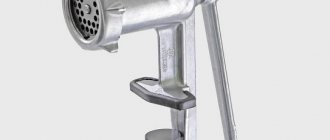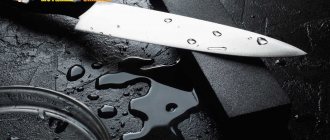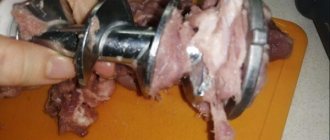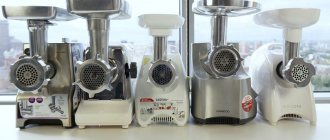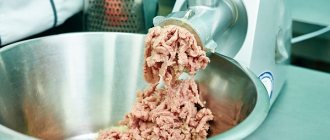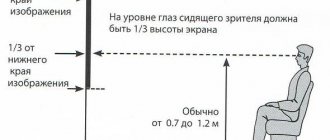Design and principle of operation
The meat grinder consists of the following units:
- housings with a neck for loading and a cylindrical part for the location of the auger;
- auger;
- a knife attached to the auger;
- a fixedly fixed grille, which is fixed with a nut to the body;
- handles for rotating the auger.
The operating principle is as follows:
- The diced meat is loaded into a special receiving hopper.
- When the handle connected to the auger rotates, the meat from the hopper flows to the cutting tool, passes through it to the mesh holes, and then is fed out.
Meat grinder knives allow you to grind the original products and then use a mesh to give them the desired shape. Grids can be installed with different numbers and diameters of holes.
When is sharpening needed?
It is necessary to sharpen the meat grinder if it stops cutting meat, the hopper near the mesh is constantly clogged. Often dull cutting edges are caused by:
- the use of poor steel in the manufacture of a meat grinder;
- grinding meat with bones or tendons;
- storing equipment in a room with high humidity.
In some cases, the wear of the grate does not allow it to come into close contact with the blade, which also negatively affects the quality of meat chopping.
In such situations, the process of self-sharpening blades on a metal grid becomes ineffective. Even minor damage to the edges will reduce functionality. To verify their presence, just unscrew the side cover of the case and inspect the condition of the blades.
Rusted mesh and knife (Photo: Instagram / zatochka_yuao)
Sharpening rules
When sharpening meat grinder knives, you need to consider the following rules:
- the abrasive tool must have a flat plane;
- The blades should be lubricated before sharpening to prevent scratches from falling chips or splinters during processing;
- to uniformly remove layers of metal, it is necessary to ensure uniform pressure over the entire area of the blade being sharpened;
- the plane of the metal mesh requires alignment so that when assembling the meat grinder there are no gaps between the rubbing planes above the permissible level.
Sharpening methods
You can sharpen a knife from a meat grinder:
- whetstone;
- on the machine;
- sandpaper.
Abrasive stone
Sharpening stones are bars made of natural or artificial stone. Advantages:
- low material cost;
- Possibility of step-by-step quality control of sharpening.
Flaws:
- low processing speed;
- when using low-quality stones with non-uniform grains, damage to the sharpened surface is possible;
- you need a set of stones with different roughness.
You can sharpen meat grinder knives with a sharpener as follows:
- A stone with a roughness of 40–60 microns is taken and placed motionless on the table.
- The stone is lubricated with oil.
- Take a knife and apply it to the stone with its entire working plane.
- Sharpening is carried out - the cutting edge moves in a rotational-circular motion along the abrasive stone.
- The machine is periodically washed to remove chips, then lubricated again and turning is carried out again.
- Similar operations are performed with metal mesh.
Abrasive stone (Photo: Instagram /hoz.mag_real)
Grinder
The sharpening machine allows you to fix the abrasive wheel and cutting blades at the desired angles, quickly and safely sharpen edges, and perform a large volume of work with high productivity. To prevent overheating of the steel, the engine speed is adjusted.
When using machines, you need to take into account that they have a number of disadvantages:
- difficulty in controlling the turning process;
- high cost of equipment.
Electric sharpening of a knife from a meat grinder:
- A disk with a suitable roughness is fixed on the machine.
- GOI paste No. 4 is applied to the grinding wheel. Wait the time necessary for the paste to dry.
- The power to the machine is turned on. The speed is selected at which it is possible to perform safe turning without overheating the steel. The sharpening angle is set in the range of 70–80 degrees.
- The cutting edges move along the abrasive surface in a circular motion until the desired level of sharpening is achieved and a smooth, shiny edge is obtained.
- When turning for more than 5 minutes, you need to let the machine run for several minutes at idle speed so that the metal has time to cool.
- In the same way, clean the surface of the mesh until a flat plane is obtained.
Sharpening machine (Photo: Instagram / lombard_azov)
Emery cloth
Disadvantages of sandpaper:
- when turning, it is difficult to fix the blade and protect it from bends and waves;
- work must be carried out on a flat, durable surface;
- low processing speed.
Sharpening knives with sandpaper:
- Prepare a flat and durable table surface, clearing it of dirt and debris.
- Lay out and level the canvas on the table. It should be secured around the perimeter so that it cannot move or wrinkle during processing.
- Lubricate the surface of the cutting edge and sharpen it in a circular motion.
It is recommended to use fine-grained paper to avoid leaving deep scratches on the metal and to ensure uniform removal of the metal layer over the entire surface. This will increase the processing time, but the quality of sharpening will improve and the risk of errors will be minimal.
Method 2: sandpaper
On a warm autumn day, to pass the time remaining before my dentist appointment, I decided to take a walk around the market. It was very conveniently located (almost next to the clinic), and there was always something to see there.
So this time, walking between the aisles with all sorts of things, I unwittingly overheard a conversation between a seller and a buyer who demanded to give him some sandpaper to sharpen knives. This interested me, so, after waiting for the man to leave and taking advantage of the absence of other customers, I interrogated the man who was standing on the other side of the counter. It should be noted that he had limitless patience. It was for this reason that I headed out half an hour later with a set of 10 sheets of waterproof sandpaper for metal working.
We recommend: How often to change cutting boards
As the seller assured, sharpening knives with sandpaper is as easy as shelling pears. Especially if these are knives from a meat grinder. The sharpening process itself, according to him, looked like this:
- You need to place a piece of paper on a very flat, smooth surface. If it is lumpy, ribbed or anything else, nothing good will come of it. Even one small grain caught under a sheet of sandpaper can ruin everything.
- Place the knife on top so that its cutting edges touch the abrasive surface.
- Press the knife down with your fingers and rotate it counterclockwise. It is very important to do exactly this, and not the other way around.
- After a while the edges will begin to shine. When their entire surface becomes silvery-shiny, the sharpening process can be considered complete.
However, that's not all. In order for the meat grinder to work no worse than the jaws of a megalodon, you need to put in order the metal mesh (a circle with holes) through which the minced meat passes. The manipulations with it are the same as with a knife, but it is advisable to bring it to an even shine on both sides. By the way, you can rotate the grid in any direction, and not strictly counterclockwise.
Since this method was suitable for both an electric meat grinder and a manual one, I decided to first test it on knives from a cheaper device. I did everything as the seller advised, assembled the meat grinder, took out the meat I had bought for the occasion from the refrigerator and was truly surprised - the old meat grinder was grinding the beef as if it were apples. And this despite the fact that she had original knives—made in 1958.
Carrying out a repeat experiment, now with the participation of a knife from a modern and quite expensive meat grinder, was no longer scary. And the result was again pleasing! Subsequently, I used this method exclusively for 5 or 6 years, and even now it remains my favorite.
We recommend: How to remove scratches on laminate flooring in an apartment?
How to sharpen at home?
At home, you can only properly sharpen knives by hand, especially if you have no experience. Processing with sharpeners allows you to fully control the quality of the surface, eliminate defects in a timely manner, and monitor the angle of the blade edge.
Sequencing:
- In the store you need to purchase a sharpening disc with a diameter of 180 mm and a grain size of up to 50 microns.
- Prepare a container into which you can completely immerse the disk. Water is poured into it.
- The disc is securely fixed inside the container.
- Take a knife, place the blade on the sharpening wheel, then make circular movements along its surface. The pressure should be even.
- At short intervals the quality of turning is checked. When the entire surface is shiny, you can proceed to the next stage.
- Perform steps 4 and 5 for steel grating.
- Two sharpened parts are joined.
Sharpening at home (Photo: Instagram / nikolai.4695)
How to sharpen meat grinder knives
Unbelievable but true! For more than 100 years, the idea of Karl Dres, the inventor and creator of a device that harmoniously fits into our everyday life and is called a MEAT GRINDER, has remained unchanged.
And indeed, whether it is a MMS (mechanical auger meat grinder) or an EMS (electric auger meat grinder), the operating principle remains the same. It is worth noting that modern meat grinders have slightly modified internal components, which makes it possible to process the original product very quickly with minimal labor costs. The essence of the work of a meat grinder is this: a product is fed into the opening of the meat receiver, then the screw shaft crushes and pushes the meat to the knife and the grates, which, like scissors, close into the even corners of the knife and grate, giving out the desired minced meat, be it pate, cutlet or chopped.
But there is nothing eternal either in nature or in everyday life. There comes a time when it is necessary to sand or replace the blade and grate. It is recommended to do both simultaneously, namely to sharpen the movable and stationary knife (knife and grid) at the same time. This is due to the fact that the corners in the knife and the corners in the grid openings are rounded and change the plane of the working area, and the cutting edge in the grid holes is larger than in a cross-shaped knife; the grid cuts more than the knife! Customers often say that replacing the grid and knife improves the operation of the meat grinder several times and the device works like new!
Often they replace grid No. 2 (meat), the cell diameter of which is 4-5 mm, because it is used more often than others.
It is worth remembering that in the absence of special equipment it is not always possible to sharpen parts correctly. If processed incorrectly, a gap is formed through which small fibers pass and the efficiency of the device is reduced to a minimum. When sharpening at home on a conventional grinding wheel, it is impossible to meet all the requirements for processing spare parts.
It is important to know!
— Grinding is carried out on a professional machine with a centered magnetic plate, due to which the plane of the grating becomes perfectly flat around the entire perimeter. The height of each blade of the knife also remains the same.
— A professional machine is equipped with a tool cooling system, otherwise microcracks will form, which will significantly reduce the service life of the knives.
— The ideal option is when the machine operates on the “Yula” principle, when the magnetic plate and the abrasive stone rotate simultaneously, such machines allow you to grind any cutting tool.
Trust the professionals and forget about minor everyday inconveniences!
Professional Sanding Item:
Russia, Moscow region, Mytishchi, Kolpakova street, 2, 141002
https://stepl.ru
Advice from the experts
Masters advise sharpening knives for meat grinders in compliance with the following recommendations:
- the abrasive surface must have a smooth, flat surface;
- It is not recommended to use abrasive tools with large grains;
- to grind the surface, it is necessary to apply GOI paste No. 4 to the surfaces to be sharpened;
- sharpening must be carried out with step-by-step quality control of the edges;
- when processing metal, it is more profitable to choose the minimum frequency of disk rotation on machines;
- when sharpening an edge manually, you need to perform rotational 8-shaped movements on the abrasive wheel;
- It is not allowed to use circles or bars whose surface has uneven wear;
- rubbing parts should be sharpened on the same wheel so that the surfaces have the same roughness and get used faster during work.
The quality of sharpening can be determined as follows: place the thread between the cutting edges and the steel mesh, and then try to cut it. If the attempt is unsuccessful, you should repeat the sharpening procedure again.
Tips for sharpening a meat grinder knife
Nevertheless, it is worth paying attention to tips that can make the process of sharpening blades easier and will allow you to figure out how to sharpen a meat grinder knife and whether it is worth doing it at all:
- If you need to sharpen a knife, but have nothing with which to sharpen it, it makes sense to cut a circle out of wood or plastic and stick sandpaper on it. Instead of a grate, you need to place this structure in the unit and make 20–30 revolutions. The blade will become very sharp, and without much effort.
- In the event that no sharpening methods produce results, it is best to purchase a new knife.
- Separately, it should be noted that self-sharpening knives do not exist, so you should not spend money purchasing widely advertised products.
